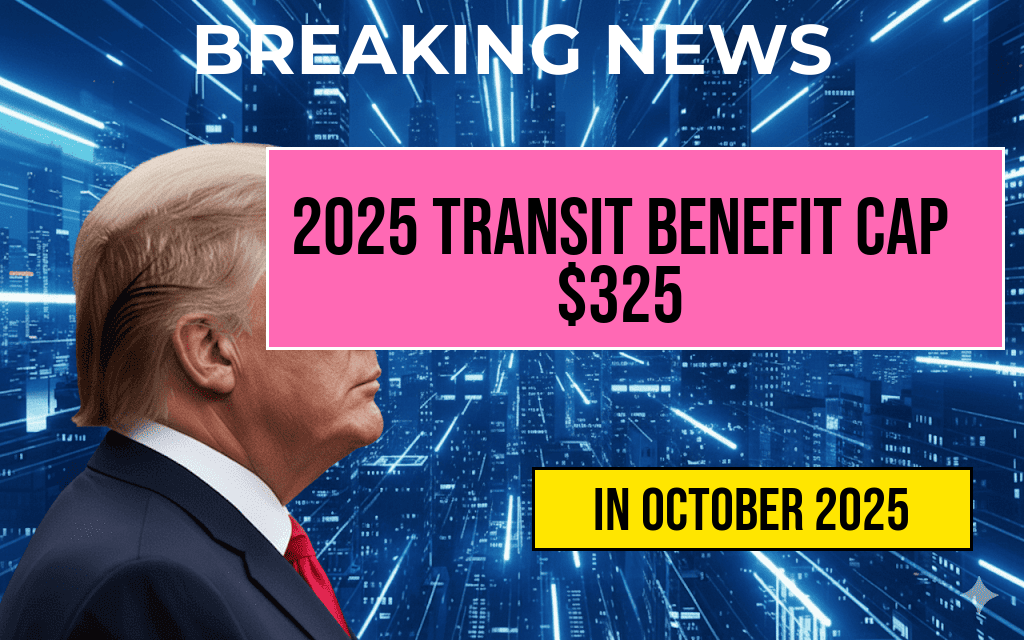The 2025 transit benefit cap has been officially set at $325 per month, marking a significant adjustment in federal transportation benefits for millions of employees across the United States. This cap, part of ongoing efforts to modernize employer-sponsored transportation programs, determines the maximum amount employers can exclude from employees’ taxable income when subsidizing commuting expenses. The new limit, which takes effect in January 2025, represents a modest increase from the previous cap of $280. For many commuters, this adjustment translates into increased monthly savings, particularly for those relying heavily on public transit or alternative transportation options. Employers and employees alike will need to review how this change impacts their benefits packages and commuter strategies, especially as urban mobility continues to evolve amid changing work environments and transportation infrastructure investments.
Understanding the Transit Benefit Cap and Its Significance
What Is the Transit Benefit Cap?
The transit benefit cap is a federal limit on the amount of qualified transportation benefits that employers can provide to employees on a pre-tax basis. These benefits typically include subsidies for public transit fares, vanpooling costs, and certain bicycle commuting expenses. By establishing a cap, the Internal Revenue Service (IRS) aims to balance incentivizing sustainable commuting options with tax revenue considerations. Legally, employers can offer benefits up to the cap amount without treating the value as taxable income for employees, providing a direct financial advantage for those using public transportation.
Why the Cap Is Increasing in 2025
The adjustment to $325 reflects annual inflation adjustments mandated by federal law, specifically designed to keep pace with rising transportation costs. The increase from $280 to $325 signifies an approximate 16% rise, aligning with broader economic factors affecting commuting expenses. This change aims to support the shifting landscape of urban mobility, where public transit fares and associated costs continue to grow, especially in major metropolitan areas.
How the New Cap Affects Employees and Employers
Monthly Savings and Budgeting
For employees, the increased cap means the potential to save more tax-free dollars each month on commuting expenses. For example, a worker who spends $300 monthly on transit can now receive a benefit of up to $325 without additional tax implications, potentially increasing their savings by around 16%. Those with higher commuting costs, such as $350 or more, will still be limited to the $325 threshold, but the higher cap allows for greater flexibility in employer subsidies and personal budgeting.
| Year | Cap Amount | Percentage Increase |
|---|---|---|
| 2024 | $280 | – |
| 2025 | $325 | 16.1% |
Impacts on Employers
Employers benefit from offering transit benefits up to the new cap by attracting and retaining employees who prioritize sustainable commuting options. The higher limit encourages more comprehensive transit subsidies, which can be a valuable part of employee benefits packages. Nonetheless, organizations need to update their benefits administration systems to accommodate the new maximum, ensuring compliance and optimal benefit design.
Broader Context: Trends in Urban Transportation and Policy
Supporting Sustainable Commuting
The increase in the transit benefit cap aligns with federal initiatives promoting environmentally friendly transportation choices. Encouraging public transit use reduces traffic congestion and lowers carbon emissions, supporting climate goals outlined in policy frameworks like the climate change mitigation strategies. Many cities are investing in transit infrastructure, making the subsidy cap a timely incentive for commuters to shift away from personal vehicles.
Adapting to Changing Work Patterns
The rise of hybrid and remote work models has altered commuting patterns, but many employees still rely on daily transit. The increased cap provides added flexibility for those returning to in-person work or combining remote days with transit use. Employers are increasingly integrating transportation benefits with broader wellness and sustainability initiatives, emphasizing their role in fostering a green and efficient workforce.
Resources and Next Steps
Employees and employers should review their current benefits structures to identify potential adjustments in light of the new $325 cap. Consulting IRS guidance and transportation benefit providers can help ensure proper compliance and maximize savings. For detailed information, visit the IRS official website on Transit Benefits and related updates (IRS Publication 15-B) or industry insights from transportation advocacy groups.
As transportation costs and policies continue to evolve, staying informed will be key to leveraging benefits effectively. The 2025 increase reflects ongoing efforts to make sustainable commuting options more accessible and financially attractive, fostering a shift toward greener urban mobility.
Frequently Asked Questions
What is the new 2025 Transit Benefit Cap?
The 2025 Transit Benefit Cap has been set at $325 per month, representing the maximum amount an employee can receive in pre-tax transit benefits for the year 2025.
How does the monthly savings work with the new cap?
Employees can save up to $325 each month through pre-tax transit benefits, which reduces taxable income and results in significant monthly savings.
Who is affected by the Transit Benefit Cap?
The Transit Benefit Cap primarily affects employees who use transit benefits as part of their compensation package, ensuring they receive tax advantages up to the $325 monthly limit.
Will the cap increase in the future?
While the $325 cap is set for 2025, future adjustments depend on legislation and policy changes; it’s important to stay informed about any updates from your employer or relevant authorities.
How can I maximize my transit benefit savings under this cap?
To maximize savings, plan your commuting expenses to stay within the $325 monthly limit and utilize pre-tax transit benefits to reduce your taxable income effectively.






